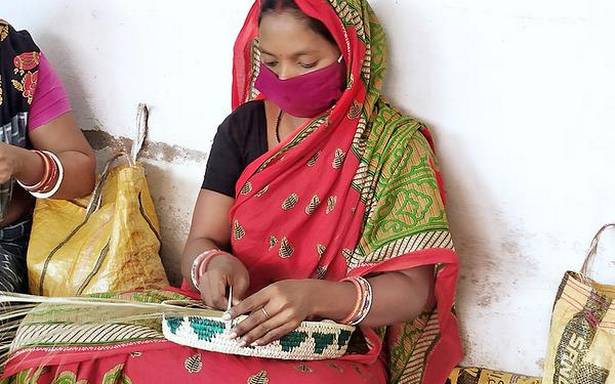Trained by National Institute of Design, Ahmedabad, women in Mayurbhanj innovate their way to success in pandemic
They found an opportunity during a pandemic. While the COVID-19 outbreak cast immense misery on the livelihood of millions in the country, a tribe in Odisha’s Mayurbhanj district took up the challenge to expand its wares.
A group of 200 women belonging to the Bathudi tribe in a remote village of Mayurbhanj began research and development in their own small way and are now reaping the benefits. From a basket of 100 crafts made of the Sabai grass, they have churned out 300 crafts in a year.
The Sabai grass is a natural fibre grown abundantly in the hilly areas of Mayurbhanj. About a decade ago, it was mainly used for making ropes only.
“In 2020, when the sale of the Sabai grass craft had gone down and the orders dried up, we decided to make best use of the lean period. We decided to explore what other crafts could be made out of the grass,” said Usharani Naik, who leads the Gohaldihi cluster of artisans in Mayurbhanj district.
New designs, products
The Gohaldihi cluster, involving 232 artisans across 14 villages, was identified as a potential Sabai Grass Craft Cluster for the programme intervention of the Scheduled Castes and the Scheduled Tribes Research and Training Institute, Bhubaneswar, with the support of the Odisha Mineral Bearing Areas Development Corporation.
Ms. Naik said, “Our members started exploring possibilities of creating a new craft out of the grass…we came up with new designs and products and gave shape to those as finished products. We discovered that our range of products had rapidly increased from 100 odd crafts to 300.”
After COVID-19 lockdown measures were relaxed, the market for the Sabai grass bounced back. “Our products have been appreciated. The annual turnover shot up to ₹1 crore,” she said.
By making products such as a foot mat to jewellery items and from vanity bags to chairs, the expertise of women has improved.
The Odisha Rural Development And Marketing Society (ORMAS), an autonomous professional body under the aegis of the Panchayati Raj Department, roped in the National Institute of Design, Ahmedabad, which provided skill training for new products. The ORMAS also has tied up with the National Institute of Fashion Technology for improvement in the products. “Now, 700 to 800 artisans, mostly tribal women, are working in four clusters. The annual turnover ranges from ₹3 crore to ₹4 crore. The market is expanding. We have got export license which would enable us to send the product to foreign countries such as the U.S.A. and the United Kingdom regularly,” said Biman Mal, Deputy Chief Executive Officer of ORMAS, Mayurbhanj.
The Sabai srass usually grows in the degraded and highlands requiring little irrigation and manuring. Moreover, soil erosion is arrested to some extent by its cultivation. Mayurbhanj’s District Development Report says annual turnover of the Sabai industry can be stepped up to ₹100 to ₹200 crore.
“The annual average income of individual artisans in Gohaldihi cluster is ₹12,000 to ₹15,000 from the Sabai grass craft making. Some tribal women have become master craftspersons and are training other women,” said Manguli Naik, who herself is a master craftswoman.
Source: Read Full Article

